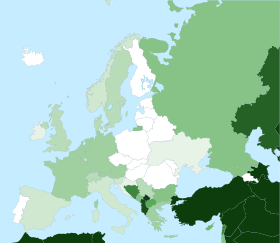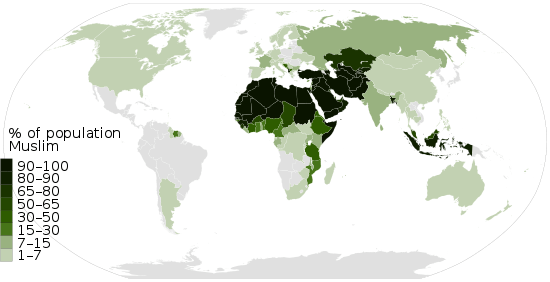Islam in Montenegro
Islam in Montenegro refers to adherents, communities and religious institutions of Islam in Montenegro. It is the second largest religion in the country, after Christianity. According to the 2011 census, Montenegro's 118,477 Muslims make up 20% of the total population.[1] Montenegro's Muslims belong mostly to the Sunni branch.
| Total population | |
|---|---|
| 118,477 (2011) | |
| Regions with significant populations | |
| Largest concentrations in the northeastern municipalities Bijelo Polje, Petnjica, Rožaje, Gusinje and Plav and southeastern municipalities Ulcinj, Bar and Tuzi. | |
| Religions | |
| Islam, Sunni, Shia | |
| Languages | |
| Montenegrin, Bosnian, Albanian and Roma |
History
In the 15th century the Montenegrin ruler Ivan Crnojević (1465–1490) was at war with the infiltrating Venetians unable to maintain war on both fronts Ottoman Empire had conquered much of Montenegro's territory and introduced Islam. Ivan's third son Staniša Crnojević was the first prominent Montenegrin of the Muslim faith, and since then Islam was not an uncommon religion to the Crnojević Montenegrin ruling dynasty.
Staniša Crnojević took up the name Skenderbeg Crnojević and ruled from his capital at Cetinje. He is well known as one of the most prominent Muslim administrators in the northern reaches of the Ottoman Empire of Slavic origins during the reign of Sultan Selim I. Staniša Crnojević is known to have commanded an army of approximately 3000 Akıncı he also maintained correspondence with neighboring contemporaries such as Gazi Husrev-beg.
Twenty-first century
The Muslims of Montenegro are mostly Bosniaks and Albanians by ethnicity, but also some are declared as ethnic Muslims and Montenegrins. The adherents of Islam in Montenegro can be mostly found in the Sandžak region in Montenegro and Ulcinj, Bar and Podgorica. Bosniaks have similar ethnic background with ethnic Muslims, but differ in ideology of what ethnicity they belong to.[2] In Montenegro are established 13 Councils of Islamic Community: Podgorica, Tuzi, Dinoša, Bar, Ostros, Ulcinj, Pljevlja, Bijelo Polje, Berane, Petnjica, Rožaje, Plav and Gusinje.
Demographics
According to the 2011 census, there are 118,477 adherents of Islam in Montenegro.
Ethnic composition of Muslims (adherents of Islam) in Montenegro:[3]
- 53,453 Bosniaks
- 22,267 Albanians
- 20,270 Muslims (distinctive ethnic group)
- 12,758 Montenegrins
- 5,034 Roma
- 2,003 Egyptians (distinctive ethnic group)
- 256 Muslims/Montenigrins
- 195 Gorani
- 183 Muslims/Bosniaks
- 181 Bosniaks/Muslims
- 172 Montenigrins/Muslims
- 169 Bosnians
- 101 Turks
- others (under 100 members per community) and ethnically undeclared
Geographical distribution

| 90–100% | |
| 70–80% | Kazakhstan |
| 50–70% | |
| 30–50% | North Macedonia |
| 10–20% | |
| 5–10% | |
| 4–5% | |
| 2–4% | |
| 1–2% | |
| < 1% |
There are large regional differences in the distribution Muslim population. Rožaje Municipality, for example, is almost exclusively inhabited by adherents of Islam, while there are zero Muslims living in Plužine Municipality.
| Municipality | Population (2011 census) [5] |
Islam/Muslim (%) |
|---|---|---|
| Rožaje Municipality | 22,964 | 94.95 |
| Plav Municipality | 13,108 | 76.64 |
| Ulcinj Municipality | 19,921 | 71.82 |
| Bijelo Polje Municipality | 46,051 | 42.65 |
| Bar Municipality | 42,048 | 30.14 |
| Berane Municipality | 33,970 | 27.97 |
| Pljevlja Municipality | 30,786 | 16.37 |
| Podgorica Municipality | 185,937 | 11.23 |
| Tivat Municipality | 14,031 | 5.10 |
| Budva Municipality | 19,218 | 3.40 |
| Herceg Novi Municipality | 30,864 | 2.01 |
| Kotor Municipality | 22,601 | 1.66 |
| Danilovgrad Municipality | 18,472 | 1.41 |
| Nikšić Municipality | 72,443 | 1.39 |
| Cetinje Municipality | 16,657 | 0.76 |
| Šavnik Municipality | 2,070 | 0.58 |
| Kolašin Municipality | 8,380 | 0.55 |
| Mojkovac Municipality | 8,622 | 0.29 |
| Andrijevica Municipality | 5,200 | 0.16 |
| Žabljak Municipality | 3,570 | 0.14 |
| Plužine Municipality | 3,800 | 0.10 |
| Montenegro | 620,029 | 19.11% |
References
- "Census of Population, Households and Dwellings in Montenegro 2011" (PDF). Monstat. pp. 14, 15. Retrieved October 16, 2016. For the purpose of the chart, the categories 'Islam' and 'Muslims' were merged.
- Dimitrova 2001, p. 94-108.
- Statistical Office of Montenegro: Population by ethnicity and religion (2011)
- "Religious Composition by Country, 2010-2050". Pew Research Center. 12 April 2015. Retrieved 22 October 2017.
- Census of Population, Households and Dwellings in Montenegro 2011
Further reading
- Dimitrova, Bohdana (2001). "Bosniak or Muslim? Dilemma of one Nation with two Names" (PDF). Southeast European Politics. 2 (2): 94–108.CS1 maint: ref=harv (link)
- Đečević, Mehmed; Vuković-Ćalasan, Danijela; Knežević, Saša (2017). "Re-designation of Ethnic Muslims as Bosniaks in Montenegro: Local Specificities and Dynamics of This Process". East European Politics and Societies and Cultures. 31 (1): 137–157. doi:10.1177/0888325416678042.CS1 maint: ref=harv (link)
- Kurpejović, Avdul (2018). Ko smo mi Muslimani Crne Gore (PDF). Podgorica: Matica muslimanska Crne Gore.CS1 maint: ref=harv (link)
External links
- http://www.monteislam.com/
- https://web.archive.org/web/20090416174648/http://www.seher-tuzi.org/
- http://www.almanah.co.me/
- http://www.savjetmuslimanacg.com

